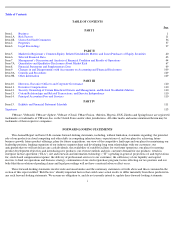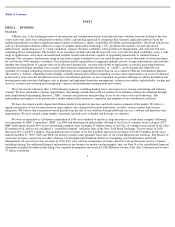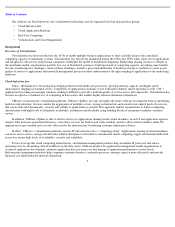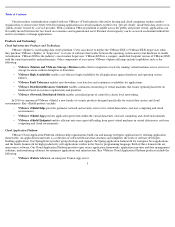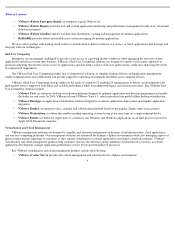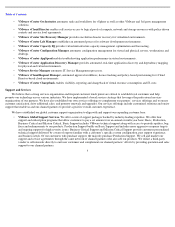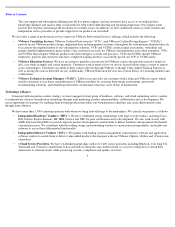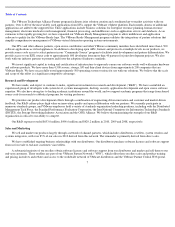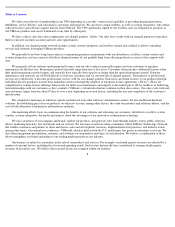VMware 2010 Annual Report Download - page 13
Download and view the complete annual report
Please find page 13 of the 2010 VMware annual report below. You can navigate through the pages in the report by either clicking on the pages listed below, or by using the keyword search tool below to find specific information within the annual report.
Table of Contents
We also compete with Citrix and its collaborations with Microsoft for end-user computing solutions and with companies whose
virtualization products are based on emerging open-source technologies. In addition, we compete with companies that take different approaches
to virtualization. Furthermore, our VMware vSphere suites compete with products that provide high availability clustering, workload
management and resource management.
We also expect to compete with new entrants to the cloud computing, end-user computing and virtualization markets, which may include
parties currently selling our products and/or our current technology partners. Existing and future competitors may introduce products in the same
markets we serve or intend to serve, and competing products may have better performance, lower prices, better functionality and broader
acceptance than our products. Our competitors may also add features to their cloud computing, end-user computing and virtualization products
that are similar to features that presently differentiate our product offerings from theirs. Additionally, some of our competitors may make
acquisitions or enter into partnerships or other strategic relationships with one another to offer more comprehensive solutions than those they
individually had offered. Some competitors have in the past, and may in the future, take advantage of their existing relationships with our
business partners to engage in business practices such as distribution and license restrictions that make our products less attractive to our channel
partners and end-users.
Information technology companies are also increasingly seeking to deliver top-to-bottom IT solutions to end-users that combine enterprise-
level hardware and software solutions that can offer alternatives to our cloud computing, end-user computing and virtualization platform. In
addition, competitors who have existing relationships with our current or prospective end-
users could integrate competitive capabilities into their
existing products and make them available without additional charge. Many of our current and potential competitors have longer operating
histories, greater name recognition, a larger customer base, and significantly greater financial, technical, sales and marketing and other resources
than we do.
Overall however, we believe our market position, large virtualization customer base, strong partner network, broad and innovative
solutions suite, and platform-agnostic approach position us to compete effectively.
Intellectual Property
As of December 31, 2010, the United States Patent and Trademark Office has issued us more than 100 patents covering various aspects of
our server virtualization and other technologies. The granted United States patents will expire beginning in 2018, with the last patent expiring in
2029. We also have numerous pending United States provisional and non-provisional patent applications, and numerous pending foreign and
international patent applications, that cover other aspects of our virtualization and other technologies.
We have registered trademarks in the United States for “VMWARE,” “VMWORLD,” “VMWARE FUSION,” “VMWARE VSPHERE,”
“VMWARE VCLOUD,” “SPRINGSOURCE,” “HYPERIC,” “VMOTION,” “ESX,” and numerous other trademarks. We have also registered
trademarks in a number of foreign countries.
We rely on a combination of patent, trademark, copyright and trade secret laws in the United States and other jurisdictions, as well as
confidentiality procedures and contractual provisions to protect our intellectual property rights and our brand.
We enforce our intellectual property rights in the United States and a number of foreign countries. Despite our efforts, the steps we have
taken to protect our proprietary rights may not be adequate to preclude misappropriation of our proprietary information or infringement of our
intellectual property rights, and our ability to police such misappropriation or infringement is uncertain, particularly in countries outside of the
United States. United States patent filings are intended to provide the holder with a right to exclude others from making, using, selling, or
importing in the United States the inventions covered by the claims of granted patents.
10


